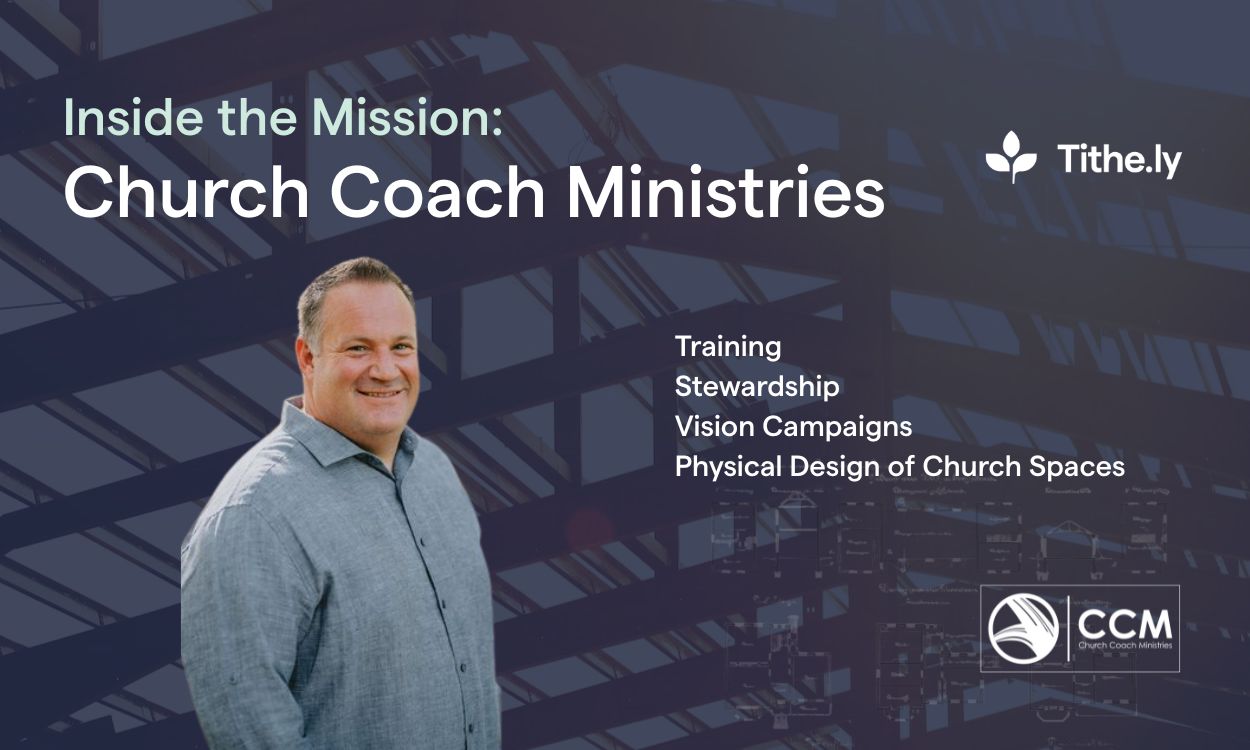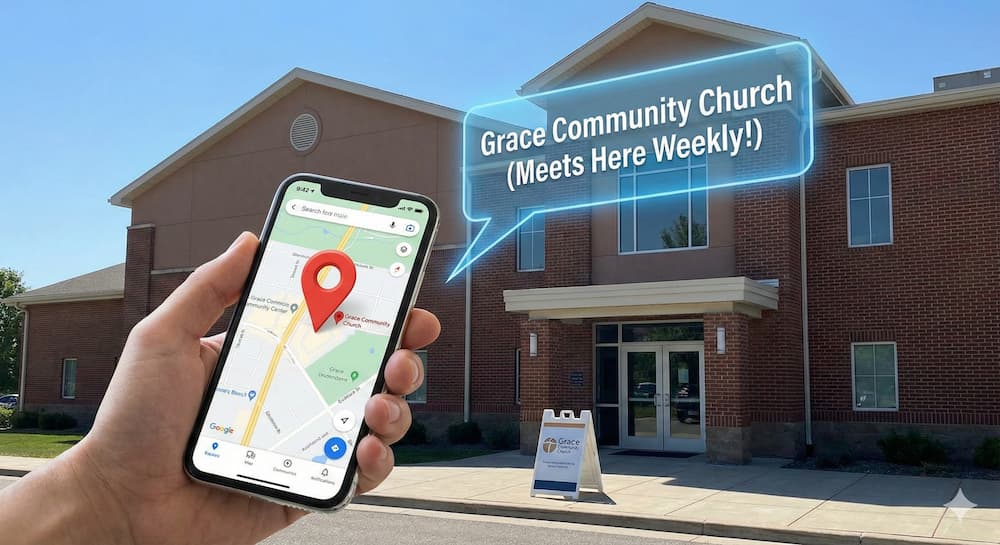5 Ways to Get Ready for a Missions Conference
Take these critical steps to make sure your missions conference is a success.

Preparing for a missions conference can put a lot of stress on your organization.
- The entire staff is taxed.
- The normal roles and responsibilities are doubled.
- The pressure to make the conference feasible is palpable.
- Everybody has a criticism of the marketing materials.
- People get resentful and jealous of others’ roles.
It’s easy to miss the big picture of what a missions conference can provide:
- Unity of purpose.
- Fresh content.
- Another year of extra revenue.
- Revitalized interest in your organization among your members and users.
- A potential national impact for your cause and vision.
- Refreshed unity among the team leadership.
But in the midst of all of the highs and lows of missions conference planning, it’s easy to lose sight of what makes a conference great:
Organization.
90% of event planning is logistics.
In terms of time spent, vision, glory, selfies, and ooh-la-la take up less than 10%.
If you are staring down the tracks at a missions conference week, you must remember to keep your eye on the essentials.
But if you don’t have your degree in event planning, it’s hard to remember what are the fundamentals and what are the glimmering distractions.
So, let’s get down to business and nail down exactly what you should focus on (and what tactics are most useful) as you prepare for your missions conference.
Here are five tools to crush missions conference week.
1. Decide who is Batman (and who is Robin)
Before you do anything, you need to decide who is the boss.
The biggest mistake organizations make when putting on a conference is creating a “committee.”
Trash the committee.
There must be one project manner who is able to be a “leader among equals.”
A successful missions conference production will be the result of solid teamwork that reflects the vision of the whole leadership team, but you need to have a trusted trigger person who can act as an executive project manner with veto power.
This doesn’t mean that this person has exhaustive administrative responsibility, or worse, comprehensive operational authority over every conference staff member and volunteer.
You don’t need a dictator.
You need a leader.
But if your organization can’t agree on a single person to oversee the missions conference project management, this signals deeper professional problems that need to be addressed before the conference production gets too much speed.
A good missions conference, by nature, will be a complex beast with many moving parts.
A good missions conference will require multiple authorities within your organization to execute diligently within their area of expertise.
But a good missions conference also must remain agile, or else its administrative back end will become too heavy, and you will discover the nightmare of having a conference that is too big even for a committee to handle.
Appointing a Batman to lead your conference’s Justice League is crucial to the operation’s ability to pivot and engage obstacles without disrupting the basic architecture of the event.
The decision not to appoint a point-person is a decision for chaos.
2. Use the right event management software from the start
First of all, don’t even think of using Google Docs and Gmail as your command central for conference organization.
While Google Suite is a very useful tool, when it comes to professional conference production, nothing says “amateur” quite like Google Docs, and nothing predicts being overwhelmed with disparate and disorganized details quite like a frenzied search through a 37-email long Gmail thread for flight details.
You need to use a professional event management software.
Thankfully, with Tithe.ly Church Management, you don't need a different tool to run a successful church event.
You have everything you need, including:
- Push notifications
- Team segmenting
- Registration tool
- Payment processing capability
- View and manage attendees
- Role/responsibility management
- Easy data export for email integration
If you’re planning a mission's conference, you should use this software to easily pull all your details into a single place.
3. Overestimate financial, personnel, and time cost
If there’s one thing conference attendees desire most, it is consistent high-quality production.
Nothing says low-quality quite like a group of feverish conference staff running around trying to fill more roles than they can manage.
Missions conference attendees want a smooth experience, and if they are constantly distracted by your event’s organizational buffering in real time, which they can see through your threadbare underestimation of how much time and money you thought it would cost, then your event is doomed.
If you think a piece of software will cost $100, budget $150.
If you think you need three people on A/V for the conference, make sure you have five.
If you can’t afford five people, make sure you have an A/V plan that only needs one person and hire three.
If your missions conference’s reach extends beyond your budgetary grasp, the production will look worse than if you had kept your original proposal modest and left a comfortable margin between your financial, personnel, and time cost and the real-time financial, personnel, and time operational needs.
4. Get the ball rolling at least a year ahead of time
If you want to plan a conference six months ahead of time, don’t.
If you’re reading this in July, don’t set your conference date until July next year.
Why would I kill your dreams like this?
So that your conference prep dreams can come true.
Here’s a basic timeline sketch that every conference has, which should require at least one year:
- 12 months out: Create conference theme and message
- 12 months out: Gather input from those internal to organization
- 12 months out: Determine who will be project manager and who will be on the conference team
- 12 months out: Consult others who have done similar conferences in the past
- 12 months out: Set budget for conference space, marketing, and attendance goals
- 12 months out: Set date, time, location
- 12 months out: Write preliminary conference schedule
- 12 months out: Make deposits for conference space
- 12 months out: Get contracts with speakers and content contributors signed and paid
- 12 months out: Confirm conference schedule
- 9 months out: Create marketing materials for conference
- 9 months out: Open and market conference pre-registration
- 6 months out: Open and market conference registration
- 3 months out: Market conference late registration
- 1 month out: Double check finances, attendees, speakers, and details
- 1 week out: Dry run through the space
5. Perform a dry run with your team
This is an important step that you must not skip with your team.
As soon as you have access to the space, and before you set up anything, do a dry run with all your staff for the conference.
Make sure you walk through the actual space and rehearse where each staff will be during each time block.
Reinforce locations for certain events/talks, establish who will be there, and run through troubleshooting protocol should something not work.
If you don’t do this before the set up begins, you open yourself up to operational liability and your preparation risks becoming weaker.
Strengthen the opportunity for your success by performing a complete dry run, from start to finish, for your entire conference.
Over to you
Don’t roll the dice on the success of your mission's conference.
You can run a successful, profitable, meaningful missions conference with almost any budget if you spend 90% of your time following this 5-step operational protocol for planning and preparation.
Do not allow yourself to indulge 40% of your time in the flashy product mockups, marketing materials, and vision meetings.
These are all important, but if the conference is going to have an impact — and more importantly, if it is going to have a second year — it must have an administrative smoothness that allows conference attendees to feel undistracted, hosted, and fully immersed in the content of the conference you produce.
Anything less than 90% commitment to acing these logistical details will yield a sub-par conference.
At best, you’ll experience diminishing numbers year over year.
At worst, you’ll experience a damaged brand reputation and a financial loss on an unimpactful event.
Don’t roll the dice.
Plan to win by winning at planning.
It all starts with setting a point person and getting Tithe.ly ChMS.
If you get these two things in place, your missions conference is on track to success.
Author: Paul Maxwell, Ph.D., is the Content Strategist at Tithe.ly. He lives in Fishers, IN with his beautiful wife and rowdy wheaten terrier.
Sign Up for Product Updates
Preparing for a missions conference can put a lot of stress on your organization.
- The entire staff is taxed.
- The normal roles and responsibilities are doubled.
- The pressure to make the conference feasible is palpable.
- Everybody has a criticism of the marketing materials.
- People get resentful and jealous of others’ roles.
It’s easy to miss the big picture of what a missions conference can provide:
- Unity of purpose.
- Fresh content.
- Another year of extra revenue.
- Revitalized interest in your organization among your members and users.
- A potential national impact for your cause and vision.
- Refreshed unity among the team leadership.
But in the midst of all of the highs and lows of missions conference planning, it’s easy to lose sight of what makes a conference great:
Organization.
90% of event planning is logistics.
In terms of time spent, vision, glory, selfies, and ooh-la-la take up less than 10%.
If you are staring down the tracks at a missions conference week, you must remember to keep your eye on the essentials.
But if you don’t have your degree in event planning, it’s hard to remember what are the fundamentals and what are the glimmering distractions.
So, let’s get down to business and nail down exactly what you should focus on (and what tactics are most useful) as you prepare for your missions conference.
Here are five tools to crush missions conference week.
1. Decide who is Batman (and who is Robin)
Before you do anything, you need to decide who is the boss.
The biggest mistake organizations make when putting on a conference is creating a “committee.”
Trash the committee.
There must be one project manner who is able to be a “leader among equals.”
A successful missions conference production will be the result of solid teamwork that reflects the vision of the whole leadership team, but you need to have a trusted trigger person who can act as an executive project manner with veto power.
This doesn’t mean that this person has exhaustive administrative responsibility, or worse, comprehensive operational authority over every conference staff member and volunteer.
You don’t need a dictator.
You need a leader.
But if your organization can’t agree on a single person to oversee the missions conference project management, this signals deeper professional problems that need to be addressed before the conference production gets too much speed.
A good missions conference, by nature, will be a complex beast with many moving parts.
A good missions conference will require multiple authorities within your organization to execute diligently within their area of expertise.
But a good missions conference also must remain agile, or else its administrative back end will become too heavy, and you will discover the nightmare of having a conference that is too big even for a committee to handle.
Appointing a Batman to lead your conference’s Justice League is crucial to the operation’s ability to pivot and engage obstacles without disrupting the basic architecture of the event.
The decision not to appoint a point-person is a decision for chaos.
2. Use the right event management software from the start
First of all, don’t even think of using Google Docs and Gmail as your command central for conference organization.
While Google Suite is a very useful tool, when it comes to professional conference production, nothing says “amateur” quite like Google Docs, and nothing predicts being overwhelmed with disparate and disorganized details quite like a frenzied search through a 37-email long Gmail thread for flight details.
You need to use a professional event management software.
Thankfully, with Tithe.ly Church Management, you don't need a different tool to run a successful church event.
You have everything you need, including:
- Push notifications
- Team segmenting
- Registration tool
- Payment processing capability
- View and manage attendees
- Role/responsibility management
- Easy data export for email integration
If you’re planning a mission's conference, you should use this software to easily pull all your details into a single place.
3. Overestimate financial, personnel, and time cost
If there’s one thing conference attendees desire most, it is consistent high-quality production.
Nothing says low-quality quite like a group of feverish conference staff running around trying to fill more roles than they can manage.
Missions conference attendees want a smooth experience, and if they are constantly distracted by your event’s organizational buffering in real time, which they can see through your threadbare underestimation of how much time and money you thought it would cost, then your event is doomed.
If you think a piece of software will cost $100, budget $150.
If you think you need three people on A/V for the conference, make sure you have five.
If you can’t afford five people, make sure you have an A/V plan that only needs one person and hire three.
If your missions conference’s reach extends beyond your budgetary grasp, the production will look worse than if you had kept your original proposal modest and left a comfortable margin between your financial, personnel, and time cost and the real-time financial, personnel, and time operational needs.
4. Get the ball rolling at least a year ahead of time
If you want to plan a conference six months ahead of time, don’t.
If you’re reading this in July, don’t set your conference date until July next year.
Why would I kill your dreams like this?
So that your conference prep dreams can come true.
Here’s a basic timeline sketch that every conference has, which should require at least one year:
- 12 months out: Create conference theme and message
- 12 months out: Gather input from those internal to organization
- 12 months out: Determine who will be project manager and who will be on the conference team
- 12 months out: Consult others who have done similar conferences in the past
- 12 months out: Set budget for conference space, marketing, and attendance goals
- 12 months out: Set date, time, location
- 12 months out: Write preliminary conference schedule
- 12 months out: Make deposits for conference space
- 12 months out: Get contracts with speakers and content contributors signed and paid
- 12 months out: Confirm conference schedule
- 9 months out: Create marketing materials for conference
- 9 months out: Open and market conference pre-registration
- 6 months out: Open and market conference registration
- 3 months out: Market conference late registration
- 1 month out: Double check finances, attendees, speakers, and details
- 1 week out: Dry run through the space
5. Perform a dry run with your team
This is an important step that you must not skip with your team.
As soon as you have access to the space, and before you set up anything, do a dry run with all your staff for the conference.
Make sure you walk through the actual space and rehearse where each staff will be during each time block.
Reinforce locations for certain events/talks, establish who will be there, and run through troubleshooting protocol should something not work.
If you don’t do this before the set up begins, you open yourself up to operational liability and your preparation risks becoming weaker.
Strengthen the opportunity for your success by performing a complete dry run, from start to finish, for your entire conference.
Over to you
Don’t roll the dice on the success of your mission's conference.
You can run a successful, profitable, meaningful missions conference with almost any budget if you spend 90% of your time following this 5-step operational protocol for planning and preparation.
Do not allow yourself to indulge 40% of your time in the flashy product mockups, marketing materials, and vision meetings.
These are all important, but if the conference is going to have an impact — and more importantly, if it is going to have a second year — it must have an administrative smoothness that allows conference attendees to feel undistracted, hosted, and fully immersed in the content of the conference you produce.
Anything less than 90% commitment to acing these logistical details will yield a sub-par conference.
At best, you’ll experience diminishing numbers year over year.
At worst, you’ll experience a damaged brand reputation and a financial loss on an unimpactful event.
Don’t roll the dice.
Plan to win by winning at planning.
It all starts with setting a point person and getting Tithe.ly ChMS.
If you get these two things in place, your missions conference is on track to success.
Author: Paul Maxwell, Ph.D., is the Content Strategist at Tithe.ly. He lives in Fishers, IN with his beautiful wife and rowdy wheaten terrier.
podcast transcript
Preparing for a missions conference can put a lot of stress on your organization.
- The entire staff is taxed.
- The normal roles and responsibilities are doubled.
- The pressure to make the conference feasible is palpable.
- Everybody has a criticism of the marketing materials.
- People get resentful and jealous of others’ roles.
It’s easy to miss the big picture of what a missions conference can provide:
- Unity of purpose.
- Fresh content.
- Another year of extra revenue.
- Revitalized interest in your organization among your members and users.
- A potential national impact for your cause and vision.
- Refreshed unity among the team leadership.
But in the midst of all of the highs and lows of missions conference planning, it’s easy to lose sight of what makes a conference great:
Organization.
90% of event planning is logistics.
In terms of time spent, vision, glory, selfies, and ooh-la-la take up less than 10%.
If you are staring down the tracks at a missions conference week, you must remember to keep your eye on the essentials.
But if you don’t have your degree in event planning, it’s hard to remember what are the fundamentals and what are the glimmering distractions.
So, let’s get down to business and nail down exactly what you should focus on (and what tactics are most useful) as you prepare for your missions conference.
Here are five tools to crush missions conference week.
1. Decide who is Batman (and who is Robin)
Before you do anything, you need to decide who is the boss.
The biggest mistake organizations make when putting on a conference is creating a “committee.”
Trash the committee.
There must be one project manner who is able to be a “leader among equals.”
A successful missions conference production will be the result of solid teamwork that reflects the vision of the whole leadership team, but you need to have a trusted trigger person who can act as an executive project manner with veto power.
This doesn’t mean that this person has exhaustive administrative responsibility, or worse, comprehensive operational authority over every conference staff member and volunteer.
You don’t need a dictator.
You need a leader.
But if your organization can’t agree on a single person to oversee the missions conference project management, this signals deeper professional problems that need to be addressed before the conference production gets too much speed.
A good missions conference, by nature, will be a complex beast with many moving parts.
A good missions conference will require multiple authorities within your organization to execute diligently within their area of expertise.
But a good missions conference also must remain agile, or else its administrative back end will become too heavy, and you will discover the nightmare of having a conference that is too big even for a committee to handle.
Appointing a Batman to lead your conference’s Justice League is crucial to the operation’s ability to pivot and engage obstacles without disrupting the basic architecture of the event.
The decision not to appoint a point-person is a decision for chaos.
2. Use the right event management software from the start
First of all, don’t even think of using Google Docs and Gmail as your command central for conference organization.
While Google Suite is a very useful tool, when it comes to professional conference production, nothing says “amateur” quite like Google Docs, and nothing predicts being overwhelmed with disparate and disorganized details quite like a frenzied search through a 37-email long Gmail thread for flight details.
You need to use a professional event management software.
Thankfully, with Tithe.ly Church Management, you don't need a different tool to run a successful church event.
You have everything you need, including:
- Push notifications
- Team segmenting
- Registration tool
- Payment processing capability
- View and manage attendees
- Role/responsibility management
- Easy data export for email integration
If you’re planning a mission's conference, you should use this software to easily pull all your details into a single place.
3. Overestimate financial, personnel, and time cost
If there’s one thing conference attendees desire most, it is consistent high-quality production.
Nothing says low-quality quite like a group of feverish conference staff running around trying to fill more roles than they can manage.
Missions conference attendees want a smooth experience, and if they are constantly distracted by your event’s organizational buffering in real time, which they can see through your threadbare underestimation of how much time and money you thought it would cost, then your event is doomed.
If you think a piece of software will cost $100, budget $150.
If you think you need three people on A/V for the conference, make sure you have five.
If you can’t afford five people, make sure you have an A/V plan that only needs one person and hire three.
If your missions conference’s reach extends beyond your budgetary grasp, the production will look worse than if you had kept your original proposal modest and left a comfortable margin between your financial, personnel, and time cost and the real-time financial, personnel, and time operational needs.
4. Get the ball rolling at least a year ahead of time
If you want to plan a conference six months ahead of time, don’t.
If you’re reading this in July, don’t set your conference date until July next year.
Why would I kill your dreams like this?
So that your conference prep dreams can come true.
Here’s a basic timeline sketch that every conference has, which should require at least one year:
- 12 months out: Create conference theme and message
- 12 months out: Gather input from those internal to organization
- 12 months out: Determine who will be project manager and who will be on the conference team
- 12 months out: Consult others who have done similar conferences in the past
- 12 months out: Set budget for conference space, marketing, and attendance goals
- 12 months out: Set date, time, location
- 12 months out: Write preliminary conference schedule
- 12 months out: Make deposits for conference space
- 12 months out: Get contracts with speakers and content contributors signed and paid
- 12 months out: Confirm conference schedule
- 9 months out: Create marketing materials for conference
- 9 months out: Open and market conference pre-registration
- 6 months out: Open and market conference registration
- 3 months out: Market conference late registration
- 1 month out: Double check finances, attendees, speakers, and details
- 1 week out: Dry run through the space
5. Perform a dry run with your team
This is an important step that you must not skip with your team.
As soon as you have access to the space, and before you set up anything, do a dry run with all your staff for the conference.
Make sure you walk through the actual space and rehearse where each staff will be during each time block.
Reinforce locations for certain events/talks, establish who will be there, and run through troubleshooting protocol should something not work.
If you don’t do this before the set up begins, you open yourself up to operational liability and your preparation risks becoming weaker.
Strengthen the opportunity for your success by performing a complete dry run, from start to finish, for your entire conference.
Over to you
Don’t roll the dice on the success of your mission's conference.
You can run a successful, profitable, meaningful missions conference with almost any budget if you spend 90% of your time following this 5-step operational protocol for planning and preparation.
Do not allow yourself to indulge 40% of your time in the flashy product mockups, marketing materials, and vision meetings.
These are all important, but if the conference is going to have an impact — and more importantly, if it is going to have a second year — it must have an administrative smoothness that allows conference attendees to feel undistracted, hosted, and fully immersed in the content of the conference you produce.
Anything less than 90% commitment to acing these logistical details will yield a sub-par conference.
At best, you’ll experience diminishing numbers year over year.
At worst, you’ll experience a damaged brand reputation and a financial loss on an unimpactful event.
Don’t roll the dice.
Plan to win by winning at planning.
It all starts with setting a point person and getting Tithe.ly ChMS.
If you get these two things in place, your missions conference is on track to success.
Author: Paul Maxwell, Ph.D., is the Content Strategist at Tithe.ly. He lives in Fishers, IN with his beautiful wife and rowdy wheaten terrier.
VIDEO transcript
Preparing for a missions conference can put a lot of stress on your organization.
- The entire staff is taxed.
- The normal roles and responsibilities are doubled.
- The pressure to make the conference feasible is palpable.
- Everybody has a criticism of the marketing materials.
- People get resentful and jealous of others’ roles.
It’s easy to miss the big picture of what a missions conference can provide:
- Unity of purpose.
- Fresh content.
- Another year of extra revenue.
- Revitalized interest in your organization among your members and users.
- A potential national impact for your cause and vision.
- Refreshed unity among the team leadership.
But in the midst of all of the highs and lows of missions conference planning, it’s easy to lose sight of what makes a conference great:
Organization.
90% of event planning is logistics.
In terms of time spent, vision, glory, selfies, and ooh-la-la take up less than 10%.
If you are staring down the tracks at a missions conference week, you must remember to keep your eye on the essentials.
But if you don’t have your degree in event planning, it’s hard to remember what are the fundamentals and what are the glimmering distractions.
So, let’s get down to business and nail down exactly what you should focus on (and what tactics are most useful) as you prepare for your missions conference.
Here are five tools to crush missions conference week.
1. Decide who is Batman (and who is Robin)
Before you do anything, you need to decide who is the boss.
The biggest mistake organizations make when putting on a conference is creating a “committee.”
Trash the committee.
There must be one project manner who is able to be a “leader among equals.”
A successful missions conference production will be the result of solid teamwork that reflects the vision of the whole leadership team, but you need to have a trusted trigger person who can act as an executive project manner with veto power.
This doesn’t mean that this person has exhaustive administrative responsibility, or worse, comprehensive operational authority over every conference staff member and volunteer.
You don’t need a dictator.
You need a leader.
But if your organization can’t agree on a single person to oversee the missions conference project management, this signals deeper professional problems that need to be addressed before the conference production gets too much speed.
A good missions conference, by nature, will be a complex beast with many moving parts.
A good missions conference will require multiple authorities within your organization to execute diligently within their area of expertise.
But a good missions conference also must remain agile, or else its administrative back end will become too heavy, and you will discover the nightmare of having a conference that is too big even for a committee to handle.
Appointing a Batman to lead your conference’s Justice League is crucial to the operation’s ability to pivot and engage obstacles without disrupting the basic architecture of the event.
The decision not to appoint a point-person is a decision for chaos.
2. Use the right event management software from the start
First of all, don’t even think of using Google Docs and Gmail as your command central for conference organization.
While Google Suite is a very useful tool, when it comes to professional conference production, nothing says “amateur” quite like Google Docs, and nothing predicts being overwhelmed with disparate and disorganized details quite like a frenzied search through a 37-email long Gmail thread for flight details.
You need to use a professional event management software.
Thankfully, with Tithe.ly Church Management, you don't need a different tool to run a successful church event.
You have everything you need, including:
- Push notifications
- Team segmenting
- Registration tool
- Payment processing capability
- View and manage attendees
- Role/responsibility management
- Easy data export for email integration
If you’re planning a mission's conference, you should use this software to easily pull all your details into a single place.
3. Overestimate financial, personnel, and time cost
If there’s one thing conference attendees desire most, it is consistent high-quality production.
Nothing says low-quality quite like a group of feverish conference staff running around trying to fill more roles than they can manage.
Missions conference attendees want a smooth experience, and if they are constantly distracted by your event’s organizational buffering in real time, which they can see through your threadbare underestimation of how much time and money you thought it would cost, then your event is doomed.
If you think a piece of software will cost $100, budget $150.
If you think you need three people on A/V for the conference, make sure you have five.
If you can’t afford five people, make sure you have an A/V plan that only needs one person and hire three.
If your missions conference’s reach extends beyond your budgetary grasp, the production will look worse than if you had kept your original proposal modest and left a comfortable margin between your financial, personnel, and time cost and the real-time financial, personnel, and time operational needs.
4. Get the ball rolling at least a year ahead of time
If you want to plan a conference six months ahead of time, don’t.
If you’re reading this in July, don’t set your conference date until July next year.
Why would I kill your dreams like this?
So that your conference prep dreams can come true.
Here’s a basic timeline sketch that every conference has, which should require at least one year:
- 12 months out: Create conference theme and message
- 12 months out: Gather input from those internal to organization
- 12 months out: Determine who will be project manager and who will be on the conference team
- 12 months out: Consult others who have done similar conferences in the past
- 12 months out: Set budget for conference space, marketing, and attendance goals
- 12 months out: Set date, time, location
- 12 months out: Write preliminary conference schedule
- 12 months out: Make deposits for conference space
- 12 months out: Get contracts with speakers and content contributors signed and paid
- 12 months out: Confirm conference schedule
- 9 months out: Create marketing materials for conference
- 9 months out: Open and market conference pre-registration
- 6 months out: Open and market conference registration
- 3 months out: Market conference late registration
- 1 month out: Double check finances, attendees, speakers, and details
- 1 week out: Dry run through the space
5. Perform a dry run with your team
This is an important step that you must not skip with your team.
As soon as you have access to the space, and before you set up anything, do a dry run with all your staff for the conference.
Make sure you walk through the actual space and rehearse where each staff will be during each time block.
Reinforce locations for certain events/talks, establish who will be there, and run through troubleshooting protocol should something not work.
If you don’t do this before the set up begins, you open yourself up to operational liability and your preparation risks becoming weaker.
Strengthen the opportunity for your success by performing a complete dry run, from start to finish, for your entire conference.
Over to you
Don’t roll the dice on the success of your mission's conference.
You can run a successful, profitable, meaningful missions conference with almost any budget if you spend 90% of your time following this 5-step operational protocol for planning and preparation.
Do not allow yourself to indulge 40% of your time in the flashy product mockups, marketing materials, and vision meetings.
These are all important, but if the conference is going to have an impact — and more importantly, if it is going to have a second year — it must have an administrative smoothness that allows conference attendees to feel undistracted, hosted, and fully immersed in the content of the conference you produce.
Anything less than 90% commitment to acing these logistical details will yield a sub-par conference.
At best, you’ll experience diminishing numbers year over year.
At worst, you’ll experience a damaged brand reputation and a financial loss on an unimpactful event.
Don’t roll the dice.
Plan to win by winning at planning.
It all starts with setting a point person and getting Tithe.ly ChMS.
If you get these two things in place, your missions conference is on track to success.
Author: Paul Maxwell, Ph.D., is the Content Strategist at Tithe.ly. He lives in Fishers, IN with his beautiful wife and rowdy wheaten terrier.


















.jpg)









